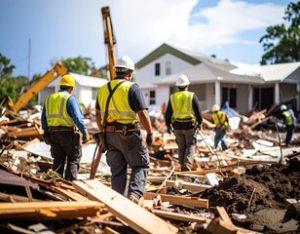Disaster cleanup isn’t just about clearing debris; it’s about mitigating further damage, ensuring safety, and bringing the property back to its former condition. It’s a complex process that requires expertise and precision.
Disaster cleanup services pride themselves on their speed, affordability, and professionalism. Their 24/7 availability means they’re ready to respond when disaster strikes. Read on to Learn More.

Safety
Whether it’s sewage flooding from hurricanes or chemical spills from manufacturing accidents, disaster cleanup and recovery requires thorough initial assessments, fast action, specialized cleanup techniques, and strict adherence to environmental regulations. Attempting to handle these tasks without a team of professionals can lead to further damage, health risks, and legal penalties.
The most important step in disaster recovery is to assess the scene of the accident or natural disaster and identify all possible hazards. This includes everything from obstructive debris to structural problems that could potentially cause further damage or injuries. In addition, hazardous waste can pose numerous dangers to workers involved in the cleanup process.
Inhaling toxic fumes can cause serious illness, even death. To prevent this, employees should wear air-purifying respirators and fully encapsulating chemical protective suits as needed. It is also vital to have appropriate levels of personal protection equipment (PPE) on hand, which can be accessed faster by having a PPE management program in place.
The right disaster cleanup service will have experience with a variety of disaster scenarios and will be able to offer 24/7 emergency services. In addition, they should have an excellent reputation, affordable rates, and a commitment to customer satisfaction. Having a pre-selected cleanup company will save time and stress in stressful situations, and it will also help businesses avoid future expenses that may be incurred due to mistakes or delays.
Reputation
Professional disaster cleanup companies have a reputation for providing fast, affordable, and professional service. They’re available 24/7, ready to respond when disaster strikes. Unlike DIY services, they prioritize safety and follow stringent environmental regulations. They also have the necessary equipment to clean up and restore damaged properties quickly and efficiently.
Disasters can destroy buildings and leave behind a mess that’s difficult to deal with. If not cleaned properly, these disasters can cause further damage and even health issues. Hiring a disaster cleanup service is the best way to get back on track and minimize damage.
While a disaster cleanup company might seem expensive, it’s worth the investment. A reputable disaster cleanup company will save you money in the long run by completing tasks efficiently and safely. Additionally, they’ll prevent future problems like mold growth that can cost you more down the road.
A disaster recovery company will also remove contaminated products from your building and transport them to a safe storage facility. This will give you the freedom to rebuild your building without worrying about contaminating new items. Moreover, they’ll also recycle your electronic waste (eWaste) properly to ensure the security of your confidential data. This is important, as hacking your hard drives can lead to serious consequences for your business.
Experience
In disaster cleanup, experience is key. Whether it is cleaning up after a manmade disaster like a chemical spill or dealing with home disasters like mold infestation, disaster cleanup services are experienced at mitigating further damage and ensuring safety. They also have the necessary knowledge and expertise to follow all environmental regulations.
Disaster cleanup services understand the need for speed and affordability. They offer 24/7 emergency response and provide affordable disaster cleanup solutions that are tailored to your specific needs. Their work is always done to the highest standard and complies with all applicable laws and regulations.
When disaster cleanup occurs, it is vital to keep in mind that there are often hidden hazards. For example, in a building that has suffered water damage, mold can start growing within 24 to 48 hours. If not dealt with quickly, it can lead to severe health problems and further structural damage.
Similarly, electronic waste (eWaste) has several sources of contamination that could impact your building. Disaster cleanup services can safely transport and dispose of these products so they do not pose a risk to your employees. They can also help you secure your data by relocating sensitive information to a safe location. This ensures that hackers cannot access your company codes, finances, and personal information. They can also recycle eWaste to protect the environment.
Equipment
Disaster cleanup services use specialized equipment like cleaning solutions, disinfectants, and fogging machines to clean and sanitize affected areas. This prevents the spread of bacteria, viruses, and other contaminants that pose health risks after a flood or sewage backup.
Disasters often result in large-scale debris that needs to be removed from the site quickly and efficiently. During the disaster recovery process, heavy machinery like excavators and bulldozers are used to clear large areas, while skid steer loaders help tackle smaller spaces that larger machines can’t reach. Together, this equipment creates a well-choreographed dance that maximizes efficiency and helps restore communities after catastrophe.
Depending on the type of disaster, hazardous waste may need to be removed from a property. Licensed professionals with training in hazardous waste management can safely and quickly remove these materials, reducing the risk of contamination and minimizing environmental harm.
Disaster cleanup services also utilize commercial-grade deodorization equipment. This includes ozone and hydroxyl generators that neutralize unpleasant odors like smoke, chemicals, and decomposing materials after disasters. These machines can be utilized in residential homes, businesses, and other commercial buildings. In addition, disaster restoration professionals use tools like containment poles and plastic sheeting to block off damaged areas, keeping debris and contaminants contained while they work on repairs. Lastly, personal protective equipment (PPE) is used to protect crew members during disaster recovery operations. This includes safety helmets, goggles, and gloves to reduce the risk of injuries from falling debris or dangerous objects.